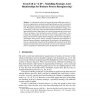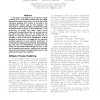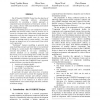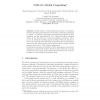ATAL
2006
Springer
13 years 8 months ago
2006
Springer
In the development of disciplines addressing dynamics, such as Mathematics and Physics, a major role was played by the assumption that processes can be modelled by introducing cer...
GTTSE
2007
Springer
13 years 8 months ago
2007
Springer
Domain-specific modelling languages provide modelling means tailored to a particular domain. In Model-driven Engineering, it is common practice to specify such languages by modelli...
WCNC
2010
IEEE
13 years 8 months ago
2010
IEEE
—One way of modelling the wireless channel is in a statistical manner, based on a few parameters describing the characteristics of the environment. In most current wireless chann...
ER
1994
Springer
13 years 8 months ago
1994
Springer
Abstract. As information systems are increasingly being called upon to play vital roles in organizations, conceptual modelling techniques need to be extended to relate information ...
IWSSD
1993
IEEE
13 years 8 months ago
1993
IEEE
In this paper, we propose the use of fine-grain process modelling as an aid to software development. We suggest the use of two levels of granularity, one at the level of the indiv...
ISORC
1998
IEEE
13 years 8 months ago
1998
IEEE
: Systems are defined by their components and the relationships among their components, hence when modelling systems using an objectoriented (OO) approach, objects alone are insuff...
APSEC
2000
IEEE
13 years 9 months ago
2000
IEEE
It has been recognised that formal methods are useful as a modelling tool in requirements engineering. Specification languages such as Z permit the precise and unambiguous modell...
EDOC
2002
IEEE
13 years 9 months ago
2002
IEEE
The EC funded COMBINE Project has the objective of dramatically improving software development productivity by providing a holistic approach to component-based development of Ente...
GLOBAL
2003
Springer
13 years 9 months ago
2003
Springer
Global systems – systems which may operate over transient networks including mobile elements and in which computation itself may be mobile – are gaining in importance. Neverthe...
CIA
2003
Springer
13 years 9 months ago
2003
Springer
Abstract. Logic programming has often been considered less than adequate for modelling the dynamics of knowledge changing over time. In this paper we describe Evolving Logic Progra...




